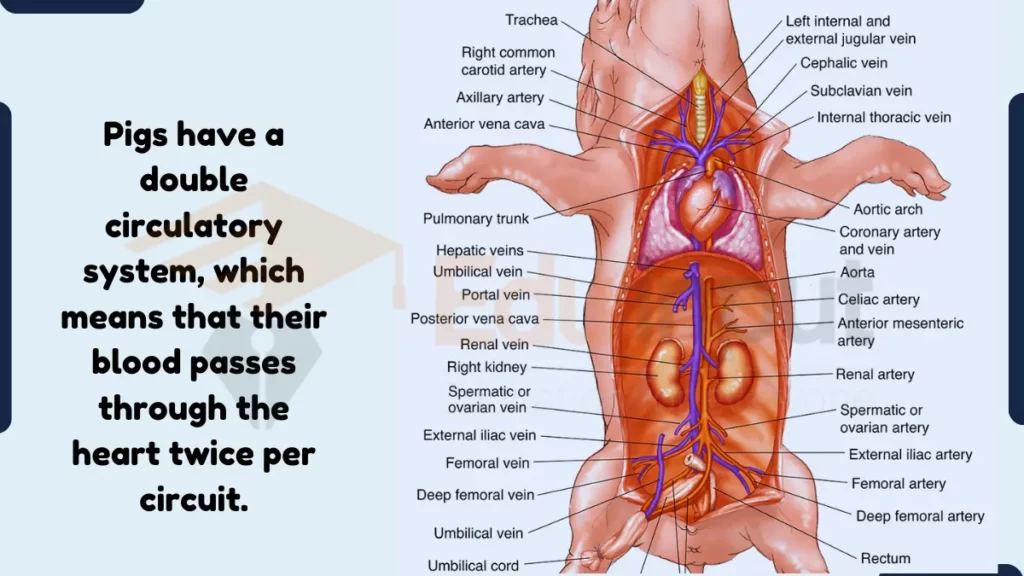Circulatory System of Pig-How Does It Work?
Pigs have a double circulatory system, which means that their blood passes through the heart twice per circuit. The first time the blood passes through the heart, it is deoxygenated and is pumped to the lungs to be oxygenated. The second time the blood passes through the heart, it is oxygenated and is pumped to the rest of the body.

Structure of Circulatory System of Pig
The circulatory system in pigs is made up of the following parts:
1. Heart
The pig heart is a four-chambered heart, consisting of the right atrium, right ventricle, left atrium, and left ventricle. The right side of the heart pumps deoxygenated blood to the lungs to be oxygenated, and the left side of the heart pumps oxygenated blood out to the rest of the body.
Pig hearts are very similar to human hearts, but there are some subtle differences. For example, the diameter of the great vessels is proportionally smaller in pigs than in humans.
2. Blood vessels
The three types of blood vessels in pigs are arteries, veins, and capillaries. Arteries carry oxygenated blood away from the heart to the rest of the body. Veins carry deoxygenated blood back to the heart from the rest of the body.
Capillaries are tiny blood vessels that connect arteries and veins. Capillaries allow oxygen and nutrients to diffuse from the blood into the tissues and waste products to diffuse from the tissues into the blood.
Also read Examples of arteries and Examples of veins
3. Blood
The blood in pigs is made up of plasma, red blood cells, white blood cells, and platelets. Plasma is the liquid part of the blood. Red blood cells contain hemoglobin, a protein that carries oxygen. White blood cells help to fight infection. Platelets help to clot blood.
There are only two blood types in pigs: A and O. This is because pigs only have two alleles for the blood type gene, A and O. In contrast, humans have three alleles for the blood type gene: A, B, and O.
How Pig’s Circulatory System Works?
The circulation of blood in pigs can be divided into two parts: pulmonary circulation and systemic circulation.
Pulmonary circulation
Pulmonary circulation is the circulation of blood between the heart and the lungs. Here Is how the circulatory system of Pig carry pulmonary circulation:
- Deoxygenated blood from the body is collected by the veins and enters the right atrium of the heart.
- Blood from the right atrium is pumped into the right ventricle.
- The right ventricle pumps blood to the lungs through the pulmonary arteries.
- In the lungs, the blood is oxygenated.
- The oxygenated blood from the lungs travels back to the heart through the pulmonary veins.
- The oxygenated blood enters the left atrium of the heart.
Systemic circulation
Systemic circulation is the circulation of blood between the heart and the rest of the body. Here Is how the circulatory system of Pig carry Systemic circulation:
- Blood from the left atrium is pumped into the left ventricle.
- The left ventricle pumps blood out to the rest of the body through the aorta.
- The aorta branches into smaller arteries, which deliver blood to all of the body’s tissues.
- Blood from the tissues travels back to the heart through the veins.
Fetal circulation in Pigs
Fetal circulation is slightly different from adult circulation because the fetus does not need to breathe air. Instead, the fetus receives oxygen and nutrients from the placenta through the umbilical vein.
- Oxygenated blood from the placenta travels to the fetus through the umbilical vein.
- The umbilical vein enters the liver, from where the blood flows into the posterior vena cava through the ductus venosus.
- The posterior vena cava carries blood to the right atrium of the heart.
- In the fetal heart, there is an opening between the right and left atria called the foramen ovale. This allows some of the oxygenated blood to flow directly from the right atrium to the left atrium, bypassing the lungs.
- Blood from the left atrium is pumped into the left ventricle, which then pumps it out to the rest of the body through the aorta.
At birth, the foramen ovale closes and the ductus venosus disappears, allowing the fetus to begin breathing air.
Also Read:



Leave a Reply